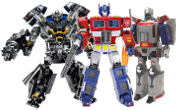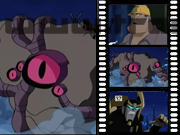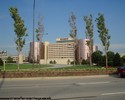
The Allspark has a nice summary of some of the information given out by Hasbro Marketing Director Mike Ballog and Director of Global Design and Development Aaron Archer
Hasbro Marketing Director Mike Ballog and Director of Global Design and Development Aaron Archer went through a Powerpoint history of Transformers, talking how 2009 was such an amazing year for the franchise in not just “Revenge of the Fallen” hitting the theaters but also it being the 25th anniversary.
Ballog mentioned that 75 percent of men between the ages of 25 and 35 in the United States today played with Transformers when they were children after it was released back in 1984. He continued on that the franchise was in part driven by TV animation, pointing out the original series being a staple after school, and that it hasn’t changed since then, with over 400 episodes and several characters being constants throughout the years. In addition, Ballog added that there’s over 6500 characters with still stories to tell, and over 5000 toys created, as well noting the progression of characters such as Optimus Prime.
Aaron points out how the characters created back then needed to be modernize, and the ways how Hasbro did it was evolve the style, using one of the slides to show the change on Optimus’ design from Generation 1, citing on making sure to keep most of the iconic elements as they moved into the more modern evolution. That was one of the challenges when it came to both theatrical films. In Devastator’s case for “Revenge”, they tried to keep core elements, such as him being a combiner composed of construction vehicles, while one of the liberties taken was tying back to the 1984 incarnation was the green portions, such as the Constructicon Long Haul who forms the right leg in “Revenge” (the G1 Long Haul formed the lower half of the body). They made a model that was almost 2-and-half-feet tall to get an idea of how he might look like in the movie-verse and the original pose was upright, but working with the art department and considering that he might not be able to support himself due to the size, they settled on a more ape-like posture on all fours. Regarding the green for the eyes and head, as well Long Haul, Aaron notes that it’s a subtle nod older fans might catch onto, whereas for the newer ones they might see it as cool. Going through concept art showing a more upright Devastator, they didn’t need to be tied to the old Devastator and went with “what were the coolest, biggest vehicles that were out there”, going with director Michael Bay wanting the largest construction vehicles possible. The end result was close to the movie model and they were happy with the portrayal, and their attitude on Devastator was that he was slow and less intelligent as he combined due to trying to hold himself together from the varying components.
Soundwave was an iconic figure from back then and since culture has moved on from the tape deck, Aaron said that Hasbro had to come up with ideas for him who is an infiltrator and spy into the film, as well keeping the concept of Soundwave deploying his subordinates. Being a spy, transforming into a spy satellite was the “perfect way” in that the Decepticons are searching for Sam and the All Spark shard, as well reinvent Soundwave into a more meaningful way today.
Ballog showed a slide of Soundwave from his 1984 release and his movie incarnation, going on how the film allowed Hasbro to generate the ‘“more than meets the eye’ experience in a number of vehicles.” People can experience the franchise by not just the movie but through the books (tie-in novels by Alan Dean Foster), the comics (published by IDW Publishing), and video games, Activision present on showcasing the game that was released around the same time as “Revenge” was. “There are all those ways to get the brand across, to enjoy those characters, and enjoy the story in a completely new way,” Ballog said, adding that since the first film “Transformers” that opportunity has expanded further beyond the action figures. From a global standpoint, while Transformers is strong within the US and in most of Asia, several examples were shown: a Peterbilt 379 in Optimus Prime’s movie design on a road tour in Poland, the recent toy fair in Hong Kong with the full scale model of Optimus in robot form, costume players (cosplayers) from Brazil, and more events at other locations. On taking pop culture to a next level, both mentioned the Transformers display at the Steven F. Udvar-Hazy Center that was alongside the same SR-71 Blackbird that plays as Jetfire’s alternate-mode in "Revenge", and how the display - prop sets and pieces - is going to be preserved at the Smithsonian. Another was the Chevrolet Camaro that was used for Bumblebee’s alt-mode, such as when it was on display at Hasbro’s booth during San Diego Comic-Con 2009. The most exciting thing for them was seeing an explosion in interest of the franchise after “Transformers” was released, noting BotCon’s attendance, and seeing the generational connection between parent and child.
After their presentation, there was a quick question-and-answer round. The third bike from “Revenge” is going to be named “Elita-1”, and more will be released come 2010. On the change of Bumblebee from a Volkswagen Beetle to a Camaro, they looked at what the character meant (Bee considered the youngest and a soldier in training, for example), and that a muscle car would be a more tactical choice in the style of the movie - they’ll transform the brand as needed, but keeping the characters was important. There were several times that Michael wanted to use certain vehicles and characters that had to be adjusted or couldn’t be used, and they helped the art department on keeping specific elements in place, such as yellow for Bumblebee and the front windshield as part of Optimus’ chest. Some Transformers had old names but were simply toys or those with new names that were new characters added new richness to the franchise, and certain characters like Alice in “Revenge” might not have translated well to toy-form or lend itself as much to the core play and the toyline. When it came to unexpected robots like Dispensor who transformed into a Mountain Dew soda dispensing machine and Ejector who was a toaster of the Kitchenbots, that was taking chances and the film provides them an opportunity to look at the brand on what the forms can be in a different way, although they can’t always have a toy for every Transformer that appears on screen.
Soundwave’s evolution before his appearance in “Revenge” was mostly focused towards toy-users, such as Animated Soundwave who had speakers. Out of the characters created, they’re trying to figure out how many have toys, as there are multiple versions, for example there were over 200 iterations of Optimus at one point. Regarding whether the early announcement of TF3’s release date changed any of their plans, Aaron answered that it changes how they’re going to handle the brand, the business opportunities, and the numerous ideas. For personal favorites to appear in the movie, both had their favorites but needed to find a balance between story and characters, and they had to hash details out with Michael and the studio. They have a tiered approach when it comes to the toys, making a variety of products that’ll be suitable to certain age levels; Devastator may have appeared complex but he’s fairly simple, whereas some figures might appear simple but are difficult to transform. Ballog said that Transformers isn’t something most of the employees at Hasbro would separate themselves from completely, being that they love the brand and the toys, and that they don’t really leave it when they return home. Aaron points out that when it’s the end of the day in Rhode Island, a new day is starting in Japan, so his clock doesn’t quite end.
On inspiration, the hope is to bring more the character – personality, motivation, seeing how they live and not just how they fight – of the robot to the toy to the best of their capabilities. Ballog admits on the new generation as well the loyal older base, and with the movie-line was expanding the ways of interaction so that the newcomers won’t have to exactly know about the whole movie, and they focus on the franchise for what it is. On how the first movie come about, Aaron said that Stephen Spielberg thought the idea could work, and Hasbro took the writers and Michael through Transformers School; no one thought possible on making a movie of Transformers due to the level of technology on graphics and whether it could be believable (hence the reason Hasbro stuck with the cartoon series).
On being asked what his role was, Aaron answered that he keeps the lore and helps people understand the brand (although he doesn’t always have the final say), and in the early process of the first film, they – Hasbro and the studios – had to figure out how they were going to have a “meaningful conversation and relationship between characters”. There was one point where none of the Transformers had any lines in the scripts, akin to Spielberg’s “E.T.” pulling heartstrings, and both men noted some of the fans’ reaction (such as flames on Optimus) but it’s very much a new take on the franchise. Speaking of the flames, it helped bring out more of Optimus’ body (the original design was mostly blue), and without Peter Cullen’s involvement, pulling people’s heartstrings wouldn’t be as effective. When asked whether they saw a difference between the toys sold via the movie versus the cartoon series, Ballog replied that it was in terms of availability, like when the original G1 series aired it was on multiple channels so there was a large reach. “What’s out there, what’s available changes” and the biggest thing was the global impact had not for the film series coming into play.
After that, the panel switched to celebrating G.I. Joe’s 45th anniversary.
Questions with Hasbro Director of Global Design and Development Aaron Archer post panel
Is a toy line similar in concept to Classics and Universe 2.0 - classic characters in updated bodies - going to be released next Fall?
Yeah, everything that isn’t movie, should fit in to that kind of area that we’re now calling Universe. So anything that doesn’t quite fit in movie, so whether it be Beast Wars, or re-imagining of , you know, Bluestreak or something, a favorite, will be in that kind of line. So we are going to do new updates.
So classic characters in updated bodies.
How many of those, I can’t really get into, but that’s something we know works for the fans, that kinda complete that new style – expression – and we’re happy to do that. We love to bring back old characters that you wouldn’t have thought we’d redo. It’s kinda a fun little designer challenge now going on. Mirage, he’s out.
Release date next fall?
I think mostly next fall is when you’ll see more of that.
Any update on release dates for the remaining Animated stuff?
[San Diego] Comic-Con, we showed what the few remaining guys were out there that we will produce at some point, whether in Animated packaging or not. But I don’t know the release dates, I focus on the creation and stuff. I don’t want to give the wrong date, but they are definitely coming out. We want all that stuff to come.
How does Hasbro handle the cultural differences, such as when it came to localizing the Unicron Trilogy and “Robots in Disguise” (“Car Robots” in Japan)?
It’s a challenge because it’s culturally two different ways to tell stories. So we kinda trade off – we wanted a particular type of thing, Takara will need a certain type of thing. What works well in the Japanese market is kinda the combining figures and different event-base products coming out, so there’s telling those stories, and we have a different take on that. So we make compromises on both sides and try to make it work. For Animated, it was more of a US-led production, and I think they’re trying to figure it out on their end how they’re going to make it fit into the universe they have. It’s not always easy but it’s not too difficult either.
Any thoughts on Japanese storytelling compared to Western storytelling?
I think for the Japanese… it’s one episode every week, it’s 52 episodes, more of a soap opera, in a way. Whereas we’re just telling fun action stories, character driven, from an American or Western sensibility, of course. Those are the really two big kind of things we navigate, and in Animated we led that production with Cartoon Network, so we didn’t do 52 episodes stand alone episodes, and all of that. It just work better for the US and some of the markets that Hasbro participates in.





















































